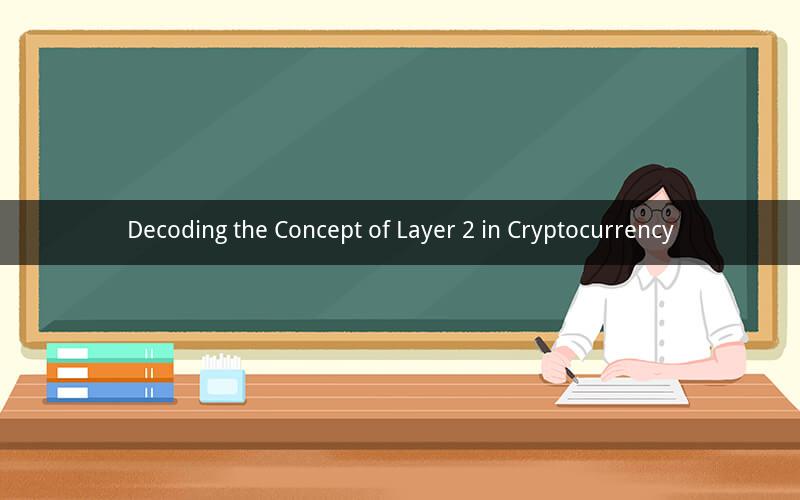
In the rapidly evolving world of cryptocurrency, the term "Layer 2" has gained significant attention. But what exactly does it mean? This article delves into the intricacies of Layer 2, its significance in the crypto space, and its potential impact on the future of blockchain technology.
Understanding Layer 2
Layer 2 refers to a secondary network that operates on top of a primary blockchain, such as Ethereum. It is designed to address some of the limitations of the underlying blockchain, such as high transaction fees and slow processing times. By offloading some of the workload from the main chain, Layer 2 aims to enhance the overall efficiency and scalability of the blockchain.
The primary purpose of Layer 2 is to improve the user experience by providing faster and cheaper transactions. It achieves this by using various techniques, such as state channels, sidechains, and rollups, to process transactions off-chain.
State Channels
State channels are one of the most popular Layer 2 solutions. They allow users to conduct multiple transactions off-chain, without the need to record each transaction on the main blockchain. This significantly reduces transaction fees and processing times.
To understand state channels, imagine two friends who want to exchange a series of messages without sending them through a crowded marketplace. Instead, they establish a private channel between them, where they can send messages directly to each other. Similarly, state channels enable users to conduct transactions off-chain, without involving the main blockchain.
Sidechains
Sidechains are another Layer 2 solution that allows for the creation of separate blockchains that can interact with the main blockchain. This allows for the transfer of assets between the two blockchains, while still maintaining the security and decentralization of the main chain.
Sidechains can be used for various purposes, such as creating new tokens, running decentralized applications (dApps), or even as a way to improve the scalability of the main blockchain.
Rollups
Rollups are a relatively new Layer 2 solution that aims to combine the benefits of both state channels and sidechains. They allow for the processing of transactions off-chain, while still maintaining the security of the main blockchain.
In a rollup, transactions are batched together and then submitted to the main blockchain as a single transaction. This reduces the number of transactions that need to be recorded on the main chain, thereby improving scalability and reducing fees.
The Significance of Layer 2
The introduction of Layer 2 solutions has had a significant impact on the crypto space. By addressing the limitations of the underlying blockchain, Layer 2 has made it more accessible and user-friendly for a wider audience.
Here are some of the key benefits of Layer 2:
1. Lower transaction fees: By processing transactions off-chain, Layer 2 solutions can significantly reduce transaction fees, making crypto transactions more affordable for users.
2. Faster processing times: Layer 2 solutions can process transactions much faster than the main blockchain, improving the overall user experience.
3. Enhanced scalability: Layer 2 solutions can help improve the scalability of the main blockchain, allowing for more transactions to be processed simultaneously.
4. Improved security: By using techniques such as fraud proofs and fraud proofs, Layer 2 solutions can maintain the security of the main blockchain while still allowing for off-chain transactions.
The Future of Layer 2
The future of Layer 2 looks promising, with several projects and initiatives underway to further improve the technology. Here are some of the key developments to watch out for:
1. Cross-chain interoperability: As more Layer 2 solutions are developed, there is a growing need for interoperability between different Layer 2 networks. This will allow for seamless transactions between different blockchains, further enhancing the user experience.
2. Improved security: As Layer 2 solutions become more widespread, there is an increased focus on improving their security. This includes the development of new protocols and algorithms to ensure that transactions are secure and tamper-proof.
3. Increased adoption: With the benefits of Layer 2 solutions becoming more apparent, we can expect to see increased adoption of these technologies in the crypto space.
Frequently Asked Questions
1. What is the difference between Layer 1 and Layer 2?
Layer 1 refers to the primary blockchain, while Layer 2 refers to a secondary network that operates on top of the primary blockchain.
2. Can Layer 2 solutions replace Layer 1?
While Layer 2 solutions can address some of the limitations of Layer 1, they cannot replace it entirely. Layer 1 remains essential for maintaining the security and decentralization of the blockchain.
3. Are Layer 2 solutions secure?
Layer 2 solutions can be secure, but they also come with their own set of risks. It is important to understand the underlying technology and protocols before using any Layer 2 solution.
4. Can Layer 2 solutions be used for all types of transactions?
Layer 2 solutions are best suited for transactions that do not require high levels of security or decentralization. They are not suitable for transactions that involve sensitive data or require a high level of trust.
5. What is the future of Layer 2?
The future of Layer 2 looks promising, with ongoing research and development aimed at improving the technology. We can expect to see increased adoption, improved security, and greater interoperability between different Layer 2 networks.